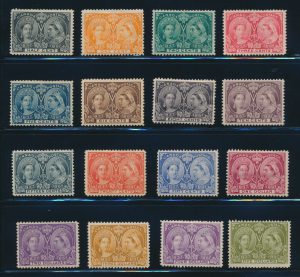By Jesse Robitaille
Insuring a stamp collection is the same as insuring anything else you own.
Similar to insuring a house, its contents or any other personal possessions – excluding your car, which is mandatory – a stamp collection can be insured for a “catastrophic loss.”
“Whether you have it or not is a question of whether you want to face your loss or share your misery with someone else, namely an insurance company,” said Garfield Portch, a retired insurance broker who manages member and chapter insurance plans for the Royal Philatelic Society of Canada (RPSC).
“Most people want to insure, but they have to think of it in a couple of terms,” said Portch, who has more than a quarter-century of professional insurance experience.
First off, what are you insuring a collection for?
“You can insure it because you’re going to keep a collection for a long period of time, and in the event of a loss, you’re intending to replace it.”
Collectors seeking insurance must establish a specific replacement value, which is “somewhat different than the value of holding a collection,” Portch said.
In holding a collection, you may have $100,000 worth of material; however, when you eventually sell it to a dealer, you’ll be selling everything for about half of its catalogue value, so a collection’s replacement value might only be $50,000.
“You have to be very careful with the limits you choose because one of the principles of insurance is you can’t make a profit from a loss. You can only recover what you lost, and that’s one of the basic tenets of insurance.”
After deciding if you want insurance and what amount of insurance you need, there are two options, one of which is to append it on a residential policy – like renter, condo or homeowners insurance – which will have a section covering stamps, coins and other collectibles.
“Dealing with a residential policy – and I say this as a retired insurance broker – there are significant disadvantages.”
While it’s often more expensive, residential policies also place “very serious limits” on the amount of insurance as well as certain restrictions on the coverage, said Portch, who’s also a Fellow of the RPSC.
“Generally, the coverage is only available while the stuff is in your home – so no shows, and no clubs. Once you’re outside the residence, all bets are off. That’s a serious restriction and one many people don’t think about.”
COMPREHENSIVE COLLECTOR POLICIES
The other option is to insure with an outside source such as Hugh Wood Canada, which manages insurance policies for the RPSC and American Philatelic Society.
Established by late collector Hugh Wood, who died last year, his namesake insurance company has more than 300 employees working in 10 countries, including Canada.
“This is what’s known as an ‘all-risk’ policy, but it’s really ‘almost all-risk’ because there are basic exclusions such as war, riot, insurrections, rot and mildew, and these are all very understandable. But for all intents and purposes, you’re covered for any loss, anywhere, any time, any how.”
Less expensive than residential policies but “far more comprehensive,” insurance specialists are ideal for serious collectors, Portch said.
“If you have a serious collection, you are foolish to not go to an insurance specialist like Hugh Wood. With them, you can take the going market rate – you walk in and say you need insurance, and they will sell you a policy – but it’s also a big benefit for members of the RPSC. Through Hugh Wood, we offer a very specific policy, and the rates, well – you just can’t beat them with a stick.”
The price break for RPSC members “is more than the cost of membership in the RPSC,” Portch added.
“If someone wants to insure their collection, if for no other reason, join the Royal and get the bargain rates. It’s a big win-win situation: the Royal gets more members, Hugh Wood gets more clients and the member gets incredibly good insurance at a reasonable price.”
Understanding an insurance policy – that is, knowing how to read it – is another important part of the deal.
“For most policies, you read what you’re covered for, and if it’s not one of those things, you’re not covered,” said Portch. “On the other hand, with an ‘all-risk’ or comprehensive policy, you’re covered for everything, so you read the exclusions because you’re covered for everything else.”
WHY INSURANCE IS IMPORTANT

An 1897 ‘Jubilee’ set with all examples in mint hinged condition (except for the $5 and 10-cent stamps, which are never hinged) recently brought $2,300 at auction in Ottawa. (Photo by Sparks Auctions)
Insurance is important to collectors for several reasons, namely as protection against significant loss.
“How big of a loss can you afford to take?” asked Portch. “If you have a smaller collection and can afford to walk away from $10,000 or $25,000, then don’t bother insuring it. That’s a lot of money when you have to come up with it, but it’s like anything else – how much loss can you absorb yourself? That’s the key question for whether you insure and how much you insure for.”
While stamps are generally replaceable, each piece of postal history is unique and has no exact replacement.
“If you collect Very Fine, mint never-hinged stamps and lose a set of ‘Jubilees’ worth thousands of dollars, you can get another set for however much and there’s no emotional connection,” said Portch, whose collection is primarily comprised of postal history.
“If my collection goes up in smoke, I’ll get cash in lieu of it because I can’t replace it. I’ll have to live with the memories and try to replace it with the cash.”
As for who finds the replacement material for an insured collection, that’s up to the collector (or policy holder).
“If you have a collection of King George V war issues, the one-cent stamps carry a market value of one cent, so you wouldn’t insure those because they’re still a dime a dozen. You want to look at the value of key items, so inventory is crucial and photographs are even better because you can prove what you had and the condition it was in.”
Another important note for collectors is to insure their collection’s key items to their full value.
“If your collection is worth $100,000, don’t insure it for $50,000 thinking it won’t all go or be stolen – even if you’re only taking $20,000 worth to a show and leaving the rest at home. There’s a clause that kicks in called co-insurance, and it’s a technical chunk of the business, but if the collection is worth $100 and you insure it for $50 before a $40 loss, why is it the insurance company’s loss? They’ll pro-rate it, so if you only insure half, you’ll only get half of the loss. They’ll say it’s not their half that burned; it’s yours.”
Collectors seeking insurance will also want to determine “fair market value,” which is the dollar amount to be insured, Portch added.
“That’s what a willing buyer would pay a willing vendor for that collection.”
BUY INSURANCE WITH INTEGRITY
Although he’s familiar with it, Portch wants other collectors to know insurance is generally uncomplicated.
“People make it out to be complicated and are bred to think the worst of insurance companies; they have a bad name out there, but there are some really first-class operations. The insurance industry in Canada – even in the world for property and casualty – has more integrity than 90 per cent of the businesses out there. It’s very carefully run and heavily regulated. My advice for anyone buying insurance is to be brutally honest with the broker or insurance rep because if you give them all the info, they can give you the best package for your needs.”


